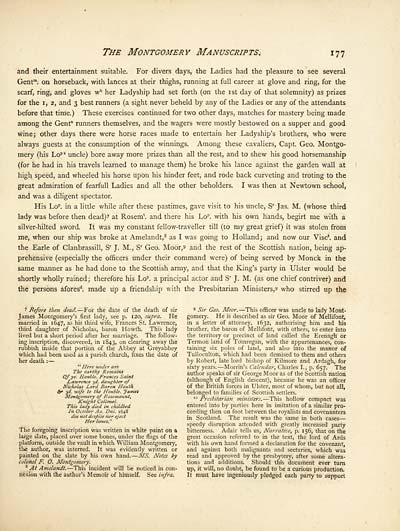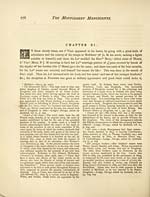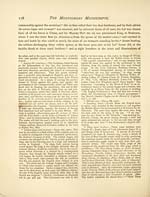Montgomery manuscripts
(191) Page 177
Download files
Complete book:
Individual page:
Thumbnail gallery: Grid view | List view

The Montgomery Manuscripts. 177
and their entertainment suitable. For divers days, the Ladies had the pleasure to see several
Gent m . on horseback, with lances at their thighs, running at full career at glove and ring, for the
scarf, ring, and gloves w h her Ladyship had set forth (on the ist day of that solemnity) as prizes
for the 1, 2, and 3 best runners (a sight never beheld by any of the Ladies or any of the attendants
before that time.) These exercises continued for two other days, matches for mastery being made
among the Gent" runners themselves, and the wagers were mostly bestowed on a supper and good
wine; other days there were horse races made to entertain her Ladyship's brothers, who were
always guests at the consumption of the winnings. Among these cavaliers, Capt. Geo. Montgo-
mery (his Lo ps uncle) bore away more prizes than all the rest, and to shew his good horsemanship
(for he had in his travels learned to manage them) he broke his lance against the garden wall at
high speed, and wheeled his horse upon his hinder feet, and rode back curveting and troting to the
great admiration of fearfull Ladies and all the other beholders. I was then at Newtown school,
and was a diligent spectator.
His Lo p . in a little while after these pastimes, gave visit to his uncle, S r Jas. M. (whose third
lady was before then dead)' at Rosem'. and there his Lo p . with his own hands, begirt me with a
silver-hilted sword. It was my constant fellow-traveller till (to my great grief) it was stolen from
me, when our ship was broke at Amelandt, 8 as I was going to Holland; and now our Vise', and
the Earle of Clanbrassill, S r J. M., S r Geo. Moor,s and the rest of the Scottish nation, being ap-
prehensive (especially the officers under their command were) of being served by Monck in the
same manner as he had done to the Scottish army, and that the King's party in Ulster would be
shortly wholly ruined; therefore his Lo p . a principal actor and S r J. M. (as one chief contriver) and
the persons afores d . made up a friendship with the Presbitarian Ministers^ who stirred up the
' Before tlien dead. — For the date of the death of sir ' Sir Geo. Moor. — This officer was uncle to lady Mont-
James Montgomery's first lady, see p. 120, supra. He gomery. He is described as sir Geo. Moor of Mellifont,
married in 1647, as his third wife, Frances St. Lawrence, in a letter of attorney, 1632, authorising him and his
third daughter of Nicholas, baron Howth. This lady brother, the baron of Mellifont, with others, to enter into
lived but a short period after her marriage. The follow- the territory or precinct of land called the Erenagh or
ing inscription, discovered, in 1843, on clearing away the Termon land of Tomregan, with the appurtenances, con-
rubbish inside that portion of the Abbey at Greyabbey taining six poles of land, and also into the manor of
which had been used as a parish church, fixes the date of Tulloculton, which had been demised to them and others
her death : — by Robert, late lord bishop of Kilmore and Ardagh, for
"Here under are sixty years. — Morrin's Calendar, Charles I., p. 657. The
The earthy Remains _ author speaks of sir George Moor as of the Scottish nation
Of ye. Honbie. Frances Saint , u , i, r tr v i_ j .a i_ t- rr
Lawrence 3d. daughter of (although of English descent), because he was an officer
Nicholas Lord Baron Houth of the British forces in Ulster, most of whom, but not all,
&• 3 d. wife to the Honble. James belonged to families of Scottish settlers.
KnIght'coflZ'r'"'' ™ Presbttarian ministers. -This hollow compact was
This lady died in childbed entered into by parties here in imitation of a similar pro-
In October Ao. Dni. 1648 ceeding then on foot between the royalists and covenanters
doe not^desj^se nor eject m Scotland. The result was the same in both cases-
speedy disruption attended with greatly increased party
The foregoing inscription was written in white paint on a bitterness. Adair tells us, Narrative, p. 156, that on the
large slate, placed over some bones, under the flags of the great occasion referred to in the text, the lord of Ards
platform, outside the vault in which William Montgomery, with his own hand formed a declaration for the covenant,
the author, was interred. It was evidently written or and against both malignants and sectaries, which was
painted on the slate by his own hand. — MS. Notes by read and approved by the presbytery, after some altera-
colonel F. O. Montgomery. tions and additions. Should this document ever turn
8 At Amelandt. — This incident will be noticed in con- up, it will, no doubt, be found to be a curious production,
nexion with the author's Memoir of himself. See infra. It must have ingeniously pledged each party to support
and their entertainment suitable. For divers days, the Ladies had the pleasure to see several
Gent m . on horseback, with lances at their thighs, running at full career at glove and ring, for the
scarf, ring, and gloves w h her Ladyship had set forth (on the ist day of that solemnity) as prizes
for the 1, 2, and 3 best runners (a sight never beheld by any of the Ladies or any of the attendants
before that time.) These exercises continued for two other days, matches for mastery being made
among the Gent" runners themselves, and the wagers were mostly bestowed on a supper and good
wine; other days there were horse races made to entertain her Ladyship's brothers, who were
always guests at the consumption of the winnings. Among these cavaliers, Capt. Geo. Montgo-
mery (his Lo ps uncle) bore away more prizes than all the rest, and to shew his good horsemanship
(for he had in his travels learned to manage them) he broke his lance against the garden wall at
high speed, and wheeled his horse upon his hinder feet, and rode back curveting and troting to the
great admiration of fearfull Ladies and all the other beholders. I was then at Newtown school,
and was a diligent spectator.
His Lo p . in a little while after these pastimes, gave visit to his uncle, S r Jas. M. (whose third
lady was before then dead)' at Rosem'. and there his Lo p . with his own hands, begirt me with a
silver-hilted sword. It was my constant fellow-traveller till (to my great grief) it was stolen from
me, when our ship was broke at Amelandt, 8 as I was going to Holland; and now our Vise', and
the Earle of Clanbrassill, S r J. M., S r Geo. Moor,s and the rest of the Scottish nation, being ap-
prehensive (especially the officers under their command were) of being served by Monck in the
same manner as he had done to the Scottish army, and that the King's party in Ulster would be
shortly wholly ruined; therefore his Lo p . a principal actor and S r J. M. (as one chief contriver) and
the persons afores d . made up a friendship with the Presbitarian Ministers^ who stirred up the
' Before tlien dead. — For the date of the death of sir ' Sir Geo. Moor. — This officer was uncle to lady Mont-
James Montgomery's first lady, see p. 120, supra. He gomery. He is described as sir Geo. Moor of Mellifont,
married in 1647, as his third wife, Frances St. Lawrence, in a letter of attorney, 1632, authorising him and his
third daughter of Nicholas, baron Howth. This lady brother, the baron of Mellifont, with others, to enter into
lived but a short period after her marriage. The follow- the territory or precinct of land called the Erenagh or
ing inscription, discovered, in 1843, on clearing away the Termon land of Tomregan, with the appurtenances, con-
rubbish inside that portion of the Abbey at Greyabbey taining six poles of land, and also into the manor of
which had been used as a parish church, fixes the date of Tulloculton, which had been demised to them and others
her death : — by Robert, late lord bishop of Kilmore and Ardagh, for
"Here under are sixty years. — Morrin's Calendar, Charles I., p. 657. The
The earthy Remains _ author speaks of sir George Moor as of the Scottish nation
Of ye. Honbie. Frances Saint , u , i, r tr v i_ j .a i_ t- rr
Lawrence 3d. daughter of (although of English descent), because he was an officer
Nicholas Lord Baron Houth of the British forces in Ulster, most of whom, but not all,
&• 3 d. wife to the Honble. James belonged to families of Scottish settlers.
KnIght'coflZ'r'"'' ™ Presbttarian ministers. -This hollow compact was
This lady died in childbed entered into by parties here in imitation of a similar pro-
In October Ao. Dni. 1648 ceeding then on foot between the royalists and covenanters
doe not^desj^se nor eject m Scotland. The result was the same in both cases-
speedy disruption attended with greatly increased party
The foregoing inscription was written in white paint on a bitterness. Adair tells us, Narrative, p. 156, that on the
large slate, placed over some bones, under the flags of the great occasion referred to in the text, the lord of Ards
platform, outside the vault in which William Montgomery, with his own hand formed a declaration for the covenant,
the author, was interred. It was evidently written or and against both malignants and sectaries, which was
painted on the slate by his own hand. — MS. Notes by read and approved by the presbytery, after some altera-
colonel F. O. Montgomery. tions and additions. Should this document ever turn
8 At Amelandt. — This incident will be noticed in con- up, it will, no doubt, be found to be a curious production,
nexion with the author's Memoir of himself. See infra. It must have ingeniously pledged each party to support
Set display mode to:
![]() Universal Viewer |
Universal Viewer | ![]() Mirador |
Large image | Transcription
Mirador |
Large image | Transcription
Images and transcriptions on this page, including medium image downloads, may be used under the Creative Commons Attribution 4.0 International Licence unless otherwise stated. ![]()
| Histories of Scottish families > Montgomery manuscripts > (191) Page 177 |
|---|
| Permanent URL | https://digital.nls.uk/95235219 |
|---|
| Description | A selection of almost 400 printed items relating to the history of Scottish families, mostly dating from the 19th and early 20th centuries. Includes memoirs, genealogies and clan histories, with a few produced by emigrant families. The earliest family history goes back to AD 916. |
|---|

